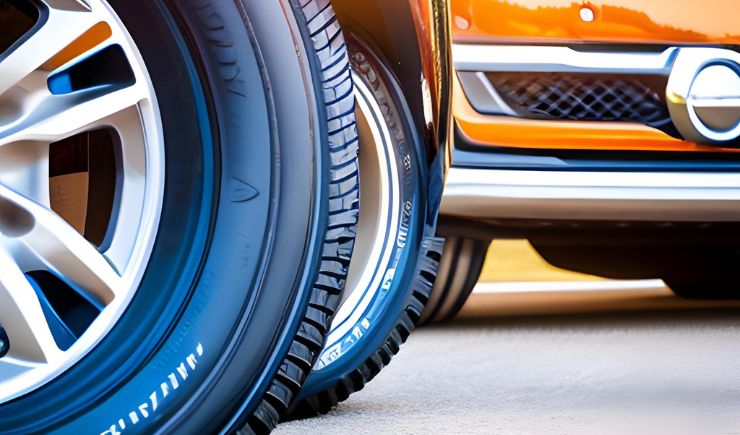Does Cold Weather Make Tire Pressure Low

Are you a car owner who has been wondering why your tire pressure is suddenly lower during cold weather? You’re not alone. Many drivers have noticed that their tires seem to lose air when the temperature drops, but what causes this phenomenon? In this article, we’ll take a closer look at how cold weather affects tire pressure and explore some tips to help keep your tires properly inflated over winter.
Tire inflation is an important part of routine vehicle maintenance for any driver – it helps ensure safe driving conditions, fuel efficiency, and even extends the life of your tires. But if you live in an area with colder climates or experience seasonal changes in temperature, understanding how these fluctuations affect tire performance can prove invaluable. We’ll examine why cold temperatures lead to decreased tire pressure and provide advice on keeping your tires inflated all year round.
Table of Contents
- How Cold Weather Affects Tire Pressure
- How To Check Tire Pressure In Cold Weather
- Adjusting Tire Pressure In Cold Weather
- Preventative Maintenance In Cold Weather
- Tips For Driving In Cold Weather
- Frequently Asked Questions
- Conclusion
How Cold Weather Affects Tire Pressure
The chill of winter can be bone-numbing, and car owners must also consider that their vehicle can feel the cold too. Tire pressure is one area where frigid temperatures make a huge difference—it’s like dropping an ice cube into a pot of boiling water! When the mercury plunges, air contracts and tire pressure drops precipitously.
This isn’t just theory either; it’s science! According to Dalton’s Law of Partial Pressure, gases contract inversely with temperature changes. This means when the outdoor temperature decreases, so does your tires’ PSI. It doesn’t take long for these effects to set in either; depending on the speed at which temperatures drop, you could see noticeable deflation within minutes!
It pays to stay vigilant then and keep tabs on your tire pressure during colder months. Otherwise, not only do you risk decreased handling abilities due to lower levels of grip but you might find yourself dealing with costly repairs down the road. Stay ahead of this wintry weather by preparing accordingly – read our next section to learn how!
How To Check Tire Pressure In Cold Weather
Keeping up with tire pressure is essential for safe driving, especially in cold weather. When temperatures drop, air molecules inside the tires contract and cause the pressure to decrease. It’s important to check your tire pressure regularly during the winter season so you can avoid potential issues like flat tires or poor handling on slippery surfaces.
To measure the current tire pressure of each wheel, you’ll need a digital or analog tire gauge. Begin by unscrewing the valve caps from each wheel, then press the nozzle of the gauge firmly onto one of them until you hear a hiss as it begins to take a reading. Wait for about 10 seconds before removing the device; this will give an accurate measurement. Continue taking readings around all four wheels until you have all their measurements recorded.
Now that you know how much air is currently within your tires, compare it against what’s recommended in your vehicle’s manual. If there are any discrepancies between those two numbers, adjust accordingly – but make sure not to go over whatever the maximum inflation level is stated in the manual! With that said, let’s move on to adjusting tire pressure in cold weather…
Adjusting Tire Pressure In Cold Weather
It’s important to know how to check tire pressure in cold weather, but it is also important to know how to adjust the tire pressure. Cold weather can cause a decrease in air pressure and it’s critical that you keep an eye on your tires before heading out for a drive. Low tire pressure can be dangerous, causing poor handling of the vehicle and reduced fuel efficiency.
To make sure your tires are ready for any road condition, here are some tips on adjusting tire pressure in cold weather: First, use a reliable gauge to measure the air pressure in each tire. In colder temperatures, aim for about 10 psi more than what’s recommended when driving in warmer conditions. If you notice one or two tires with lower pressures than normal, fill them up until they reach the desired levels. It’s also important to regularly check all four tires during the winter months as they may need topping off due to temperature changes throughout the day.
Finally, if you want maximum performance from your car this winter season, preventive maintenance is key. Make sure you get regular oil changes and tune-ups so that your engine is running smoothly and efficiently no matter how low temperatures drop outside! With these simple steps taken care of, you’ll be prepared for whatever comes your way while driving through harsh winter climates.
Preventative Maintenance In Cold Weather
Winter weather brings its own set of challenges for car owners. Cold temperatures can take a toll on your vehicle, especially tires which are essential to safe driving. To prevent problems in cold weather, basic prevention maintenance is necessary.
Tire pressure should be monitored regularly and adjusted as needed based on changing temperature levels – the colder it gets outside, the more pressure will decrease inside the tire. Tire treads need to remain deep enough to provide proper traction in wet or icy conditions; you may want to invest in winter-specific tires if they exist for your make and model. Don’t forget about engine coolants either! The correct mixture prevents freezing and overheating during extreme temperature changes.
Checking wiper blades, headlights and other lights fixtures beforehand ensures visibility when road conditions worsen due to snowfall or sleet. Keeping up with oil changes throughout the year also keeps engines running smoothly through any climate condition change.
These common maintenance tasks help keep vehicles properly prepared:
- Monitor tire pressures & adjust accordingly
- Check tire tread depth & consider winter/all-season tires
- Maintain adequate coolant mixture
- Inspect windshield wipers & headlight functions
Don’t let cold weather put a damper on all those miles ahead – taking preventive measures now helps ensure smooth sailing later down the road… And speaking of roads, here’s what drivers should know before hitting them this season.
Tips For Driving In Cold Weather
The winter season brings with it a new set of challenges for car owners. The cold weather can take its toll on your vehicle, and one thing to keep an eye out for is tire pressure. Properly inflated tires are essential for any car’s performance during the colder months.
| Temperature | Tire Pressure Difference | Recommended Adjustment |
|---|---|---|
| 0-10°F | 3-4 PSI | Increase |
| 10-20°F | 2-3 PSI | Increase |
| 20+°F | 1 PSI | Decrease or Maintain |
If you find that your tires have become deflated in the cooler temperatures, don’t worry because this is normal. Most drivers will see a decrease in their tire pressure when driving in cold weather – but there are ways to combat low tire pressure if needed. To maintain optimal traction and safety while driving, adjust your air pressure according to the temperature outside as seen in the table above. Make sure not to overinflate either; too much air can cause just as many issues as having too little!
You may also want to consider investing in snow tires for added protection during icy conditions. Not only do they provide extra grip on slick surfaces, but they also prevent hydroplaning by pushing away water from underneath your wheels quickly and efficiently. Ultimately, taking preventive measures against danger on the roads is key when dealing with cold weather car maintenance – so make sure to check those tires before hitting the road this winter!
Frequently Asked Questions
How Often Should Tires Be Checked In Cold Weather?
Do cold temperatures have an effect on your tires? With winter weather fast approaching, it’s essential to know how often you should check the pressure in your tires when the temperature drops. As a car enthusiast, staying informed is key to ensure safe and reliable performance on the road. So, how often should tires be checked in cold weather? While there are no definitive rules regarding tire pressure checks during colder months, experts recommend checking them at least once a month – or with every tank of gas – as extreme changes in temperature can cause fluctuations that could lead to potential safety hazards.
What Type Of Tires Are Best For Cold Weather Driving?
When it comes to cold weather driving, the type of tire you choose can make a big difference in your safety and comfort. All-season tires are a popular choice for many drivers; they offer reliable grip in wet conditions while still providing decent handling on dry roads. But if temperatures drop below freezing, winter tires may be a better option — as their unique tread design provides more traction in snow and ice. They also tend to handle well at low temperatures, so if you live in an area with harsh winters then winter tires should definitely be considered.
What Is The Recommended Tire Pressure For Cold Weather?
Keeping your tires properly inflated is essential for ensuring a safe and comfortable ride in cold weather. An often overlooked element of winter driving, the proper tire pressure can make all the difference when it comes to rushing through snow-covered roads or traversing icy terrain. The recommended tire pressure for cold weather ranges from 28-34 PSI – so don’t be caught out in the chill with underinflated tires! Make sure you check your car’s manual or ask an expert if you’re unsure what your vehicle requires.
What Should Be Done If The Tire Pressure Is Too Low In Cold Weather?
If a driver finds their tire pressure too low in cold weather, they should check the recommended PSI for their vehicle and add air to return it to proper levels. This can be done either at home with an air compressor or by visiting a nearby gas station with an air pump. If the added air does not bring the tires up to spec, then it may be time for new tires as the old ones could have worn down from extended use.
How Does Cold Weather Affect The Wear And Tear Of Tires?
As temperatures drop, so does the condition of your tires. Cold weather can cause wear and tear to accumulate quicker than usual, resulting in a decrease in tire lifespan. In fact, it’s not uncommon for cold winter days to take their toll on tires faster than warmer months. This is due to the way rubber compounds react when exposed to lower temperatures — they become harder and less flexible which leads to an increase in rolling resistance. As such, it’s important that drivers inspect their tires during colder periods and make sure they are properly inflated as this will help reduce wear and minimize damage over time.
Conclusion
It’s essential to stay diligent with tire care in cold weather. Tires should be checked regularly, and the right type of tires should be selected for cold weather driving. Keeping an eye on recommended tire pressure can help reduce wear and tear while keeping you safe on the road. If you notice that your tire pressure is too low during colder months, don’t hesitate to pump them up or have a professional check them out; this small act can pay off big time down the line! As a car owner, understanding how cold temperatures affect your vehicle can go a long way towards ensuring safe travels all winter long.






